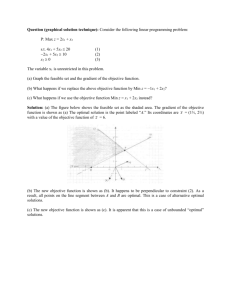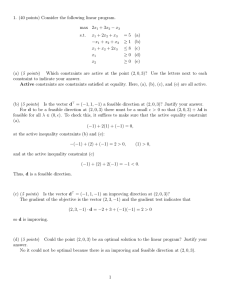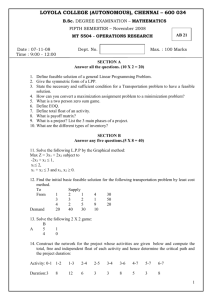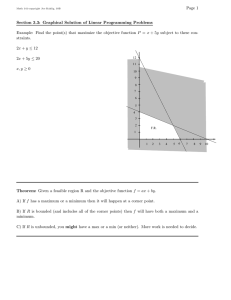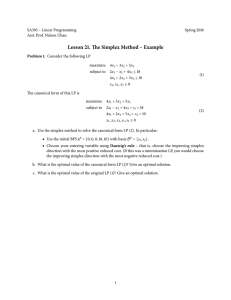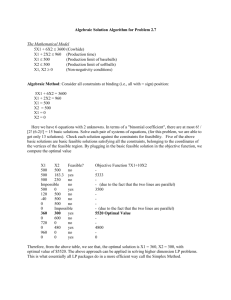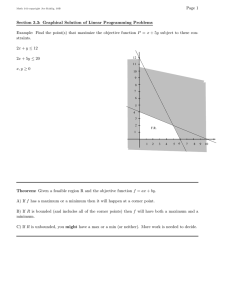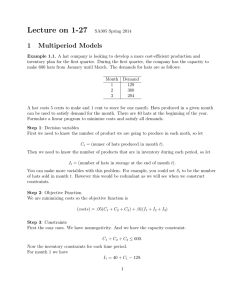Exam 2 Instructions
advertisement
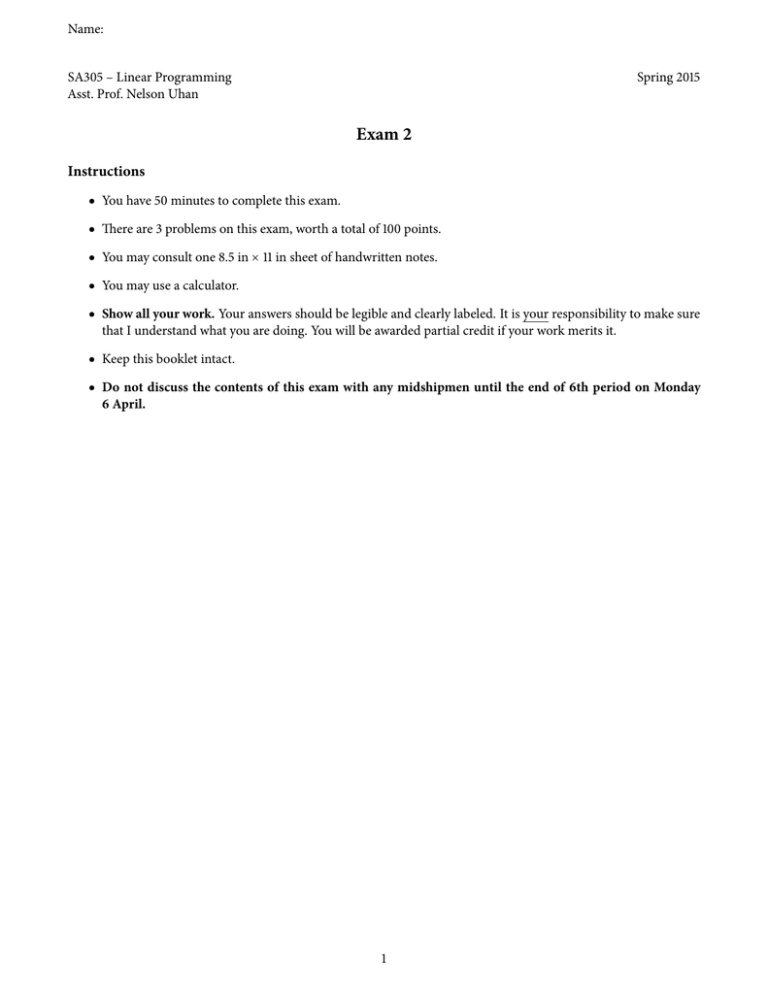
Name:
SA305 – Linear Programming
Asst. Prof. Nelson Uhan
Spring 2015
Exam 2
Instructions
● You have 50 minutes to complete this exam.
● There are 3 problems on this exam, worth a total of 100 points.
● You may consult one 8.5 in × 11 in sheet of handwritten notes.
● You may use a calculator.
● Show all your work. Your answers should be legible and clearly labeled. It is your responsibility to make sure
that I understand what you are doing. You will be awarded partial credit if your work merits it.
● Keep this booklet intact.
● Do not discuss the contents of this exam with any midshipmen until the end of 6th period on Monday
6 April.
1
Problem 1. (50 total points)
Consider the following linear program.
maximize
3x1 + 2x2 + x3
subject to
2x1 − x2 + x3 = 6
(a)
2x1 + x2
= 10
(b)
x1
≥0
(c)
≥0
(d)
x3 ≥ 0
(e)
≤4
(f)
≤3
(g)
x3 ≤ 7
(h)
x2
x1
x2
a. (30 points) For each of the following solutions, indicate whether they are (1) feasible, (2) basic solutions, and
(3) extreme points. Explain why.
⎛4⎞
x1 = ⎜ 2 ⎟
⎝0⎠
⎛0⎞
x2 = ⎜10⎟
⎝16⎠
⎛3.5⎞
x3 = ⎜ 3 ⎟
⎝2⎠
2
⎛3.75⎞
x4 = ⎜ 2.5 ⎟
⎝ 1 ⎠
b. (18 points) Consider the solution x1 defined in part a. For each of the following directions, indicate whether they
are (1) feasible at x1 and (2) improving at x1 . Explain why.
⎛−1/4⎞
d1 = ⎜ 1/2 ⎟
⎝ 1 ⎠
⎛1⎞
d2 = ⎜−2⎟
⎝−4⎠
⎛−1/2⎞
d3 = ⎜ 1 ⎟
⎝ 2 ⎠
c. (2 points) Note this linear program is of the following form:
maximize c⊺ x
subject to
Ax = b
x≥0
x≤u
This is canonical form except that the decision variables also have simple upper bounds. Recall that:
In a canonical form linear program, any basic solution has m basic variables such that
(a) the columns of A corresponding to these m variables are linearly independent;
(b) the other n − m variables are equal to 0.
Using the general definition of a basic solution, write a similar statement for linear programs of the form (∗).
3
(∗)
Problem 2. (36 total points = 12 points × 3 parts)
Consider the following linear program:
maximize
3x1 + 2x2 − x3 + 5x4
subject to
x1 − 3x2 + x3
=7
x2 + 2x3 + 4x4 = 10
x1 ,
x2 ,
x3 ,
x4 ≥ 0
Professor I. M. Wright is performing the simplex method on this linear program. The current solution is x⊺ = (7, 0, 0, 10).
In each of the steps below, he has made a mistake. Find and correct his mistakes.
a. The simplex directions are dx1 = (1, 0, −1, 1/2) and dx2 = (3, 1, 0, −1/4).
⎛3⎞
⎜2⎟
b. The simplex direction dx2 is improving because ⎜ ⎟
⎜−1⎟
⎝5⎠
⊺
⎛7⎞
⎜0⎟
⎜ ⎟ = 81.
⎜0⎟
⎝10⎠
c. After Professor Wright chooses x2 as the entering variable, he finds the step size to be λmax = 7/3.
4
Problem 3. (14 total points)
a. (4 points) Suppose x is a feasible solution to a linear program but is not a basic feasible solution. There are no
improving, feasible directions at x. Is x optimal? Explain why.
b. (5 points) A hat manufacturing plant produces baseball hats for colleges and professional leagues. Let H denote
the set of all teams they make hats for, both college and professional. For i ∈ H, let the parameter
⎧
⎪
⎪1
ti = ⎨
⎪
⎪
⎩0
if hat i is for a college team,
otherwise.
Also for i ∈ H, let x i denote a decision variable representing the number of type i hats made. Write a constraint
that could be used in a linear program that would ensure that college team hats are at least 40% of the hats made.
Use only the set, parameters, and decision variables given.
c. (5 points) Let S = {1, 2, 3, 4, 5} and
Z i = { j ∈ S ∶ j ≤ i} for i ∈ S.
Define decision variables y i for i ∈ S and parameters a i for i ∈ Z2 . Write the following constraints without for
statements and summations:
∑ y j ≥ a i for i ∈ Z2 .
j∈S
5
Additional page for answers or scratchwork
6
